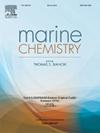Achieving measurement comparability in mercury speciation analysis in seawater: Key requirements and best practices
IF 2.5
3区 地球科学
Q2 CHEMISTRY, MULTIDISCIPLINARY
引用次数: 0
Abstract
The comparability of measurement results is an important issue in contemporary mercury (Hg) speciation in seawater. Sampling campaigns must be properly designed to determine significant differences on spatial and temporal scales, considering two major parameters: the variability of expected data at a given sampling point/transect and variability in the results due to the intrinsic properties of specific analytical methods, particularly the measurement uncertainty. This study assessed the required sample size, considering several aspects of data variability when determining total Hg, dissolved gaseous Hg, and methylated Hg species in seawater. The required sample sizes were calculated using (1) the measurement uncertainty of a single-laboratory measurement of analytical methods used; (2) performance of the laboratories in interlaboratory comparison exercises; and (3) natural variability in Hg species/fractions in a selected case study in the Central Adriatic Sea. It was shown that the measurement uncertainty of a particular method and interlaboratory variability among laboratories have significant influence on data interpretation in case natural variability of Hg fractions is relatively small, such as for example the open seawater depth profiles. In contrary, in areas with large natural variability of Hg contractions, such as coastal and contaminated sites, their influence on data interpretation is negligible. The present paper introduces the importance of proper estimation of measurement uncertainty in international programs, such as GEOTRACES, where data comparability is of fundamental importance to assess temporal and spatial trends of Hg measurements in the marine environment.
实现海水中汞形态分析的测量可比性:关键要求和最佳做法
测量结果的可比性是当代海水中汞形态形成的一个重要问题。必须适当地设计抽样活动,以确定空间和时间尺度上的显著差异,同时考虑两个主要参数:给定采样点/样条上预期数据的可变性,以及由于特定分析方法的内在特性,特别是测量不确定性而导致的结果的可变性。本研究评估了所需的样本量,在确定海水中总汞、溶解气态汞和甲基化汞的种类时,考虑了数据可变性的几个方面。所需的样本量使用(1)所用分析方法的单实验室测量的测量不确定度计算;(2)实验室在实验室间比较活动中的表现;(3)亚得里亚海中部汞种类/组分的自然变异。结果表明,在自然变异相对较小的情况下,例如开放海水深度剖面,特定方法的测量不确定度和实验室间的变异对数据解释有显著影响。相反,在汞收缩自然变异性较大的地区,如沿海和污染场地,它们对数据解释的影响可以忽略不计。本文介绍了在GEOTRACES等国际项目中正确估计测量不确定性的重要性,这些项目中数据的可比性对于评估海洋环境中汞测量的时空趋势至关重要。
本文章由计算机程序翻译,如有差异,请以英文原文为准。
求助全文
约1分钟内获得全文
求助全文
来源期刊

Marine Chemistry
化学-海洋学
CiteScore
6.00
自引率
3.30%
发文量
70
审稿时长
4.5 months
期刊介绍:
Marine Chemistry is an international medium for the publication of original studies and occasional reviews in the field of chemistry in the marine environment, with emphasis on the dynamic approach. The journal endeavours to cover all aspects, from chemical processes to theoretical and experimental work, and, by providing a central channel of communication, to speed the flow of information in this relatively new and rapidly expanding discipline.
 求助内容:
求助内容: 应助结果提醒方式:
应助结果提醒方式:


